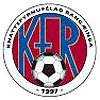
KFR Hvolsvöllur
Wikipedia - Knattspyrnufélag Rangæinga
Knattspyrnufélag Rangæinga (better known as KFR) is an Icelandic football club from the towns of Hella and Hvolsvöllur, in Rangárvallasýsla. The club represents a united team for Rangárþing (Rangárþing eystra and Rangárþing ytra). Prior to KFR's foundation the football clubs in the two towns in Rangárþing, Hekla from Hella and Baldur from Hvolsvöllur occasionally took part in the Icelandic leagues. In the years prior to KFR's foundation the clubs often fielded a merged team, calling themselves Hekla/Baldur or HB. KFR was the next step.
KFR hasn't fielded a team every season since its foundation but they've started to compete more regularly. The team achieved promotion from 3. deild in 2011 and competed in the 2012 2. deild karla, where they got relegated to 3. deild again, although this time the 3. deild isn't the lowest league in the Icelandic system following the restructuring of the league pyramid.
La squadra è stata fondata nel 1972 e ha disputato la Úrvalsdeild karla, la massima serie islandese, in una sola occasione, nella stagione 1981. Nel 2013 è tornata a disputare la seconda divisione, la 1. deild karla, dopo aver vinto la 2. deild karla, la terza divisione, nella stagione 2012.
Il KFR Hvolsvöllur ha vinto la Coppa d'Islanda in una sola occasione, nella stagione 1974.
Lo stadio del KFR Hvolsvöllur è il Hvolsvöllurvöllur, che ha una capacità di 1.000 spettatori.
I colori sociali del KFR Hvolsvöllur sono il rosso e il nero.
Il KFR Hvolsvöllur è noto per aver lanciato la carriera di alcuni giocatori di successo, tra cui Eiður Guðjohnsen, che ha giocato nella squadra nelle stagioni 1992-1993 e 1994.